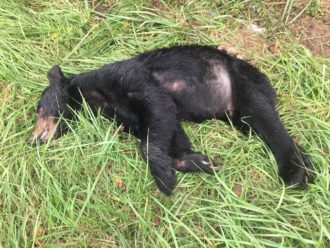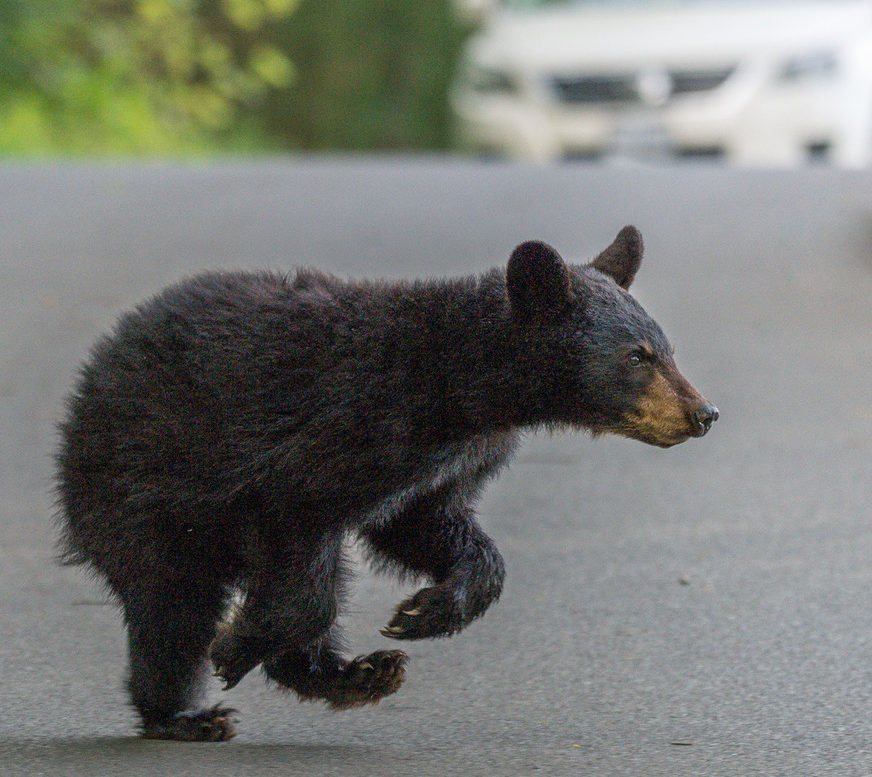The 10 a.m. movie showing on April 20 at The Strand theater in Waynesville lasted all of 16 seconds. Jeff Hunter, senior program manager at the Asheville field office of the National Parks Conservation Association, didn’t need any longer than that to make his point.
An audience of roughly 35 people looked to the screen as a mother black bear, trailed by her three cubs, clambered over the concrete Jersey barriers in the middle of Interstate 40. A line of cars and tractor-trailers stretched back for hundreds of feet at a dead stop, watching the unexpectedly graceful masses of fur navigate the asphalt and slip into the nearby woods.
For a few drivers, that encounter represented a rare photo op. For the bears, it was a close escape from the growing danger of motor vehicles in I-40’s Pigeon River Gorge, where at least 35 bears have been struck and killed since May 2018. “This is often a death trap,” Hunter said.
Once the video concluded, Hunter and other leaders in the field led a discussion about the Pigeon River Gorge Wildlife Connectivity Project, a joint effort of at least 19 nonprofit and governmental groups working to bring that death rate down. While the collaborative is relatively new — its first meeting took place in February 2017 — its members hope that opening lines of communications between stakeholders will eventually lead to better lines of movement for the region’s wildlife.
“This is not a problem that’s going to be solved next week, next month or even next year,” Hunter emphasized. “Long term, we need to identify where there’s the possibility for mitigation, get buy-in from the agencies that manage these roads and landscapes, and then we may have an opportunity.”
Under pressure
Hunter said the many groups under the connectivity project umbrella, including the N.C. and Tennessee Departments of Transportation, U.S. Forest Service, Southern Appalachian Highlands Conservancy and Rocky Mountain Elk Foundation, recognize the increasing hazards of vehicle collisions. Since the 28-mile stretch of I-40 between the Maggie Valley exit and the Foothills Parkway in Tennessee first opened in 1968, changes on both the human and animal sides of the equation have heightened the risk.

According to Bill Stiver, supervisory wildlife biologist for the nearby Great Smoky Mountains National Park, black bear populations in the park have risen from roughly 400-600 to around 1,600 over the past 30 years. Over the same period, annual park visitation has gone from approximately 8.5 million to 11.4 million — with I-40 representing a major route to the park from the east.
In a recently concluded study, Stiver continued, 90% of male bears tagged with GPS collars within park boundaries had ranges extending beyond its borders. “Essentially, the park is not big enough for the bear population to be self-sustaining,” he explained. “If those bears can’t get across I-40, they can’t get to suitable habitat.”
And elk, which were completely absent from the I-40 landscape during its planning and construction, were reintroduced in 2001. Their population now numbers about 150; a bull elk can weigh half a ton, roughly four times the weight of the average adult male bear. These massive animals, said Wildlands Network researcher Liz Hillard, are “path-of-least-resistance walkers” and often follow roads instead of climbing over mountains.
On top of these demographic changes, climate change may also increase dangerous encounters between humans and wildlife. Steve Goodman, a researcher with the NPCA, said less predictable food supplies resulting from climate disruption will force wildlife to roam farther and cross more roads in search of the next meal.
Driving with data
Animals have an easier time crossing these roads, Hunter said, if they’re given specific car-free paths such as underpasses, box culverts and green bridges to get to the other side. But constructing that infrastructure is expensive, particularly on existing highways, and the government agencies responsible for roadwork are reluctant to make big changes in haste.
“We have to have some predictability before we spend that kind of money,” said Dave McHenry, environmental supervisor for N.C. DOT Highway Division 14. “We don’t want to build something that’s not going to be used.”
McHenry also said that his department must adhere to its primary responsibility, which is to ensure the safety of the state’s motorists. While Jersey barriers may prove an obstacle to wildlife movement, he pointed out, they also keep lanes separated and prevent vehicles from flipping into oncoming traffic during an accident.
To make a stronger case for investments, the partners in the Pigeon River Gorge Wildlife Connectivity Project are conducting additional research to determine exactly how animals move about the I-40 landscape. Wildlife cameras set on the naturally occuring land bridge atop the interstate’s Snowbird Mountain tunnels in Haywood County, for example, have captured deer, bobcats and bears making their way over the road.
Hillard has placed GPS collars on 11 elk to better understand the wanderings of these recently reintroduced mammals. That work has allowed her to confirm anecdotal reports of elk crossings on I-40 and establish some seasonal movement patterns, as well as some surprising differences from other elk populations in the country.
“The movements of these elk seem to be very individualistic. Out West, these animals migrate in very large herds,” Hillard said. “We have some larger groups in Cataloochee and Oconaluftee, but very small groups [elsewhere].”
Goodman, who is collaborating with Hillard on animal movement research, added that data gathering would likely continue for several more years before solid plans could be made. “When I see a dead bear, as worrisome as it is, it’s helping us develop a database that will help us make recommendations to the DOTs for land bridges or fencing,” he said.
Bridge to the future
Hunter confirmed that the collaborative hadn’t yet made any firm commitments to wildlife connectivity infrastructure as it waits for better scientific data. “We don’t know what the solution is,” he said. “Without knowing what the solution is, you don’t know what the cost is going to be.”
However, McHenry said the NCDOT is open to opportunities that may emerge during the course of its regular maintenance. He noted that the department will soon be replacing five bridges in the Pigeon River Gorge and may consider adding wildlife-friendly features in the course of that work.
Those conversations and piecemeal projects, suggested Hunter, will lay the foundation for more comprehensive improvements in the future. Personal relationships between scientists, regulators and wildlife advocates, he said, allow everyone to “cut through the jargon” and work together in good faith.
After all, Hunter noted, animals pose a hazard to human motorists as well. According to a 2007 Federal Highway Administration report, the total average cost of a collision with a deer is nearly $8,400, while a collision with an elk costs over $18,500 on average.
“There are ongoing costs associated with wildlife-vehicle collisions — property damage, injuries,” Hunter said. “It may not be cheap to do mitigation, but it will likely be more expensive to not do mitigation in the long run.”



Before you comment
The comments section is here to provide a platform for civil dialogue on the issues we face together as a local community. Xpress is committed to offering this platform for all voices, but when the tone of the discussion gets nasty or strays off topic, we believe many people choose not to participate. Xpress editors are determined to moderate comments to ensure a constructive interchange is maintained. All comments judged not to be in keeping with the spirit of civil discourse will be removed and repeat violators will be banned. See here for our terms of service. Thank you for being part of this effort to promote respectful discussion.